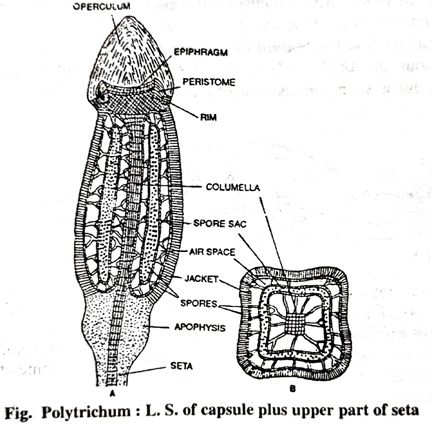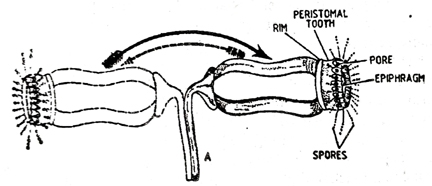Describe the structural organisation of Polytrichum capsule and its mechanism of spore dispersal.
Q. Describe the structural organisation of Polytrichum capsule and its mechanism of spore dispersal.
Ans. Capsule: It is the topmost elliptical part being 4-6 lobed, and is divisible into 3 distinct zones :
(a) Apophysis: It is the basal sterile zone being highly bulbous. It is perfectly solid and is demarcated from the theca owing to a prominent constriction carrying functional stomata in its epidermal layer. Its cortical layer are chlorophyllous.
(b) Thecal zone: It is the middle fertile zone having 2 oblong spore sacs, one on either side of the columella. This zone is composed of following structures:
(i) Jacket: It consists of a uniseriate epidermis and a 2-layered chlorophyllous
wall layers, and thus being both the protective and photosynthetic.
(ii) Trabeculae: These consist of horizontally-placed colourless septate structures enclosing plenty of air sacs. There are 2 sets of trabeculae-i.e., the outer set lies in between jacket and the spore sac, while the inner set in between columella and spore-sac.
(iii) Spore sac: Both the sacs lie suspended as per agency of trabeculae, each sac has a 2-layered wall. The formation of spore sac is correlated to the transformation of 4-6 layered sporogenous tissue into spore mother cells. Like Sphagnum, all the sporogenous cells are fertile.
(iv) Columella: It is the central conducting strand of vertically elongated thin-walled cells. It is not over-arched by sporogenous tissue rather it extends up as an epiphragm in the opercular zone.

In T. S. through thecal zone of capsule (Fig.), the squarish columella (consisting of probably 6 tiers of 6 cells each) remains surrounded by a sporesac of the same configuration; the sac eventually becomes either 4 or 6lobed.
(c) Opercular zone: It is the top most sterile zone having several specific structures that are mainly concerned in the dehiscence of capsule.
(i) Epiphragm : It is a shield- shaped membranous structure being seated immediately below the operculum. It may be compared to a stretched tympanum of a drum, closing perfectly the mouth of theca.
(ii) Operculum/lid : It is the terminal conical rostrate part that fits as a cap around the rim, and thus being helpful in closing the various other structures of the opercular zone. It is delimited from the thecal zone owing to presence of a narrow annular constriction.
(iii) Rim/Diaphragm : Seated at the base of constriction and having 2-3 layers of radially elongated thick-walled cells, the rim represents the upper part of theca.
(iv) Peristome: It arises from the diaphragm, and consists of a concentric ring of 64 pyramidal solid peristomal teeth that are joined to the margin of epiphragm with the aid of their pointed tips. It regulates the rate of spore dispersal.
Dehiscence of Capsule : The calyptra is thrown off due to swaying nature of the capsule .The capsule starts drying which causes in the separation of operculum from the rim, exposing the epiphragm and peristomal teeth. Due to strong curvature in seta immediately below the apophysis, the capsule turns to horizontal position, and develops several minute pores in between peristomal teeth at the margin of epiphragm. In the meantime the nonsporogenous portion in the centre disintegrates, so that all the meiospores (evolved due to sporogenesis) come to lie in the hollow capsule.

Fig. Polytrichum : Spore dispersal by swaying of capsule
Spores are dispersed through minute pores (formed in the opercular zone) by a censer mechanism as the capsule is in a state of constant swaying in the atmospheric air. The discharge of spores, a few at a time, is regulated by up and down movements of the epiphragm.
Follow on Facebook page – Click Here
Google News join in – Click Here
Read More Asia News – Click Here
Read More Sports News – Click Here
Read More Crypto News – Click Here